 |
Within a few months, the isotopes of Th-234 and Pa-234m grow in to the value given by the activity of the U-238. The total activity in the depleted uranium then remains constant for around 10,000 years.
Then, Th-230 with all its decay products starts growing in. After around 100,000 years, U-234 grows in to the activity level given by the U-238, further promoting the ingrowth of Th-230 and decay products.
After around 2 million years, all nuclides are in secular equilibrium, and the total activity reaches a maximum and remains at this level for a billion years.
From residual U-235, Th-231 grows in within a few days. After around 10,000 years, Pa-231 and all other decay products of the U-235 series start growing in. (see also: Uranium Decay Calculator)
Depleted uranium thus has the unusual property that it becomes more hazardous with time - an effect that has to be taken into account for its long-term management as a waste. Source
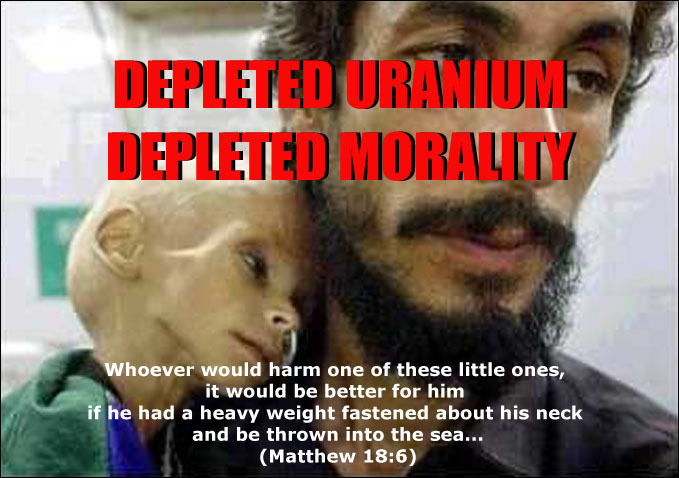
How the world works now
by Dan Eden
I'll even go one better -- I'll tell you why you don't often see a web site like this one -- viewzone -- with headline stories about these kinds of atrocities. It's quite simple. You know the answer: money.
Just have a look at this page. The story you are reading is called the "content." But you will see that on the top and the left side there are banners. That's what keep this web site alive. Viewzone get a few cents every time you click on one of them. It's the same story with television. The program you tune in to watch is also the "content" and the stuff that interrupts it, the commercials, pays for that content.
For television commercials, the network gets paid whether or not you buy the product that's being advertised. With the internet the advertisers only pay if you click on an ad banner. Just displaying it pays nothing.
So here's how it works: When the editor places a page on viewzone.com, there's a bit of code that goes where the banners are positioned. When you click on the link to the story, the code sends a signal to the ad provider that someone wants to read it. The ad provider has a powerful computer that quickly "reads" the story and determines what it's about. Then its computer decides what kind of product a person reading the story would be interested in and sends the appropriate banner to appear on the page. It all happens instantaneously and efficiently.
The problem is that no advertiser wants to be associated with "bad news" -- unless they have some product that they can sell you. Deformed babies in Iraq, poisoned by US depleted uranium shells, doesn't sell anything. Instead of some product, the ad provider will usually display a community service ad which pays nothing. Putting pages up about these kinds of topics is a net loss for viewzone -- as it is for CNN and all the other media that depend on advertising dollars.
You see? It's not a conspiracy or censorship that prevents the truth from reaching people. It's the same thing that drives everything in the world today -- money.
Your Tax Dollars At Work.
Document Reveals Military Was Concerned About Gulf War Vets' Exposure to Depleted Uranium
Wednesday 28 July 2010
by: Mike Ludwig, t r u t h o u t | Report
For years, the government has denied that depleted uranium (DU), a radioactive toxic waste left over from nuclear fission and added to munitions used in the Persian Gulf and Iraq wars, poisoned Iraqi civilians and veterans.
But a little-known 1993 Defense Department document written by then-Brigadier Gen. Eric Shinseki, now the secretary for the Department of Veterans Affairs (VA), shows that the Pentagon was concerned about DU contamination and the agency had ordered medical testing on all personnel that were exposed to the toxic substance.
Shinseki's memo, under the subject line, "Review of Draft to Congress - Health and Environmental Consequences of Depleted Uranium in the U.S. Army -- Action Memorandum," makes some small revisions to the details of these three orders from the DoD:
1. Provide adequate training for personnel who may come in contact with DU contaminated equipment.
2. Complete medical testing of all personnel exposed to DU in the Persian Gulf War.
3. Develop a plan for DU contaminated equipment recovery during future operations.
The VA, however, never conducted the medical tests, which may have deprived hundreds of thousands of veterans from receiving medical care to treat cancer and other diseases that result from exposure to DU.
The Armed Forces Health Surveillance Center recently reported that ten years of data confirm that service members tend to have higher rates of certain cancers compared to civilians, according to the Army Times. While researchers suspected that service members are diagnosed with cancer more often and at a younger age because they have guaranteed access to health care and mandatory exams, the data does not explain the disparities in diagnosis among branches of the military. For example, the rate of lung cancer among sailors is twice that of other branches, while Marines have much lower cancer rates across the board.
On Tuesday, the VA's ongoing failure to treat and diagnose Gulf War related illnesses came up during a House Veterans Affairs subcommittee hearing where a veterans advocacy group urged Shinseki to undertake comprehensive research on the correlation between chronic illness and exposure to DU in munitions during the Gulf War.
Armed with Shinseki's August 19, 1993 memo, Veterans for Common Sense (VCS), said the VA, and Shinseki in particular, have "a rare opportunity for a second chance."
"In military terms, VCS asks VA for a ceasefire," said Paul Sullivan, the executive director for VCS. "VCS urges VA leadership to stop and listen to our veterans before time runs out, as VA is killing veterans slowly with bureaucratic delays and mismanaged research that prevent us from receiving treatments or benefits in a timely manner."
Sullivan, himself a Gulf War veteran, told the subcommittee that the VA has refused to listen to scientists and veterans who are concerned about DU, leaving thousands of veterans suffering from chronic illnesses related to the conflict unsure if they will ever receive a solid diagnosis to justify the benefits and treatment they need.
Of the 697,000 men and woman who served in Gulf War operations Desert Storm and Desert Shield between 1990 and 1991, about 250,000 suffer from symptoms collectively known as "Gulf War Veterans' Illnesses." The symptoms include fatigue, weakness, gastrointestinal problems, cognitive dysfunction, sleep disturbances, persistent headaches, skin rashes, respiratory conditions and mood changes, according to the VA.
The VCS also petitioned Shinseki to investigate the 2009 termination of a $75 million research project on Gulf War illnesses at the University of Texas medical center. Last year the VCS filed a Freedom of Information Act (FOIA) request for records of the "internal sabotage" of Gulf War Veterans Illnesses research and the intentional delaying of research and treatment, according to Sullivan. The VA has yet to release any documents about the impeded research, and VCS filed a FOIA appeal on June 29.
Sullivan said the VCS simply wants the government to support independent testing on veterans exposed to DU, but the Department of Defense prefers a "don't look, don't find policy."
"As a Gulf War veteran, I have watched too many of my friends die without answers, without treatment, and without benefits," Sullivan said. "In a few cases, veterans completed suicide due to Gulf War illness and the frustration of dealing with VA."
Sullivan testified as disturbing reports have emerged in recent months from Fallujah, Iraq, about the skyrocketing rates of birth defects and cancer, which are being blamed on DU-laced bombs and munitions used by US and British forces during a brutal coalition assault on the city in 2004. Iraqi human rights officials are reportedly planning to file a lawsuit. Don’t miss a beat - get Truthout Daily Email Updates. Click here to sign up for free.
DU is a dense metal added to munitions and bombs to pierce tanks and armor, and the military seems to chose unrestricted use of the radioactive substance over its soldiers' safety. Sullivan told Truthout that original medical tests ordered in a 1993 memo, which also called for personnel to be trained in dealing with contaminated equipment, were canceled after a training video scared soldiers.
"It was pulled after [the training video] was seen by some soldiers who became upset when they saw soldiers in moon suits holding Geiger counters, and the military realized that the training could present a problem in the battlefield where soldiers need to disregard exposure issues while trying to kill the enemy," Sullivan said.
Sullivan said that the DU "follow-up" program the VA consistently references was inadequate as it consisted of sporadic studies on only a small fraction of estimated 400,000 veterans exposed to the radioactive heavy metal.
"The VA does not listen to expert scientists. The VA does not even listen to Congress," Sullivan said in his testimony. "Two decades of inaction have already passed. Gulf War veterans urgently want to avoid the four decades of endless suffering endured by our Vietnam War veterans exposed to Agent Orange."
Sullivan said it took 40 years and an act of Congress to fund and sanction independent studies that proved the VA was responsible for providing benefits to soldier suffering from Agent Orange-related diseases.
The VA now recognizes that exposure to Agent Orange, an herbicide sprayed across Vietnam to kill foliage and expose guerrilla fighters, has plagued veterans with several deadly diseases and disorders.
VCS also advocated for the research on post-traumatic stress disorder (PTSD) that became the foundation of new PTSD rules, making it easier for veterans to receive benefits.
Last week, the VA announced $2.8 million worth of research on Gulf War Veterans' Illnesses, a sum Sullivan called "paltry." A VA press release announcing the research does not mention DU. The release references a recent Institute of Medicine report that identified the quarter million veterans affected by various symptoms associated with Gulf War illness, which "cannot be ascribed to any psychiatric disorder and likely result from genetic and environmental factors, although the data are not strong enough to draw conclusions about specific causes."
Popular medical science holds that kidney damage is the primary health problem associated with exposure to high amounts of DU. The heavy metal is 60 percent as radioactive as natural uranium, and is also linked to lung cancer in some cases and leukemia in even fewer cases, according to the World Health Organization (WHO).
Some critics have claimed that the WHO and governments have suppressed links between DU and cancer.
The debate over the use of DU in conventional warfare will rage on as the Fallujah fallout continues, but according to Sullivan, there is only one way for thousands of Gulf War veterans at home to know the truth and receive the relief they deserve.
"After 20 years of waiting, we refuse to wait on more empty promises from VA. The first step is for Secretary Shinseki and Chief of Staff Gingrich to immediately clean house of VA bureaucrats who have so utterly and miserably failed our veterans for too long," said Sullivan, vowing to petition Congress if the VA refuses to respond. "Our waiting must end now."
Toxic munitions cause of baby deaths and deformities in Fallujah
By David Randall
In September this year, 170 children were born at Fallujah General Hospital, 24 per cent of whom died within seven days. Three-quarters of these exhibited deformities, including "children born with two heads, no heads, a single eye in their foreheads, or missing limbs". The comparable data for August 2002 -- before the invasion -- records 530 births, of whom six died and only one of whom was deformed.
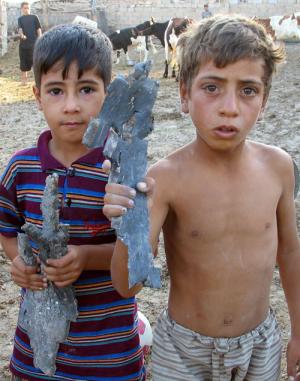 The data -- contained in a letter sent by a group of British and Iraqi doctors and campaigners to the United Nations last month -- presaged claims made in a report in The Guardian yesterday that there has been a sharp rise in birth defects in the city. The paper quoted Fallujah General's director and senior specialist, Dr Ayman Qais, as saying: "We are seeing a very significant increase in central nervous system anomalies... There is also a very marked increase in the number of cases of brain tumours." Earlier this year Sky News reported a Fallujah grave-digger saying that, of the four or five new-born babies he buries every day, most have deformities. [right: Iraqi boys play with remains of US rocket.]
The data -- contained in a letter sent by a group of British and Iraqi doctors and campaigners to the United Nations last month -- presaged claims made in a report in The Guardian yesterday that there has been a sharp rise in birth defects in the city. The paper quoted Fallujah General's director and senior specialist, Dr Ayman Qais, as saying: "We are seeing a very significant increase in central nervous system anomalies... There is also a very marked increase in the number of cases of brain tumours." Earlier this year Sky News reported a Fallujah grave-digger saying that, of the four or five new-born babies he buries every day, most have deformities. [right: Iraqi boys play with remains of US rocket.]
The campaigners' letter to the UN calls for an independent investigation to be set up, "the cleaning up of toxic materials used by the occupying forces, including depleted uranium and white phosphorus", and an inquiry launched to discover if any war crimes have been committed.
The campaigners believe that either white phosphorus or depleted uranium is a major, if not only, cause of the birth defects. White phosphorus, which US military has admitted firing on insurgents in heavily populated Fallujah, has a long history of military use, dating back to the First World War.
And although no scientific study has ever proved a causal link between depleted uranium and serious medical problems – and several studies seem to have proved the opposite -- it is by no means in the clear. Ever since the first Gulf War, its use has been linked to cancers among returning troops.

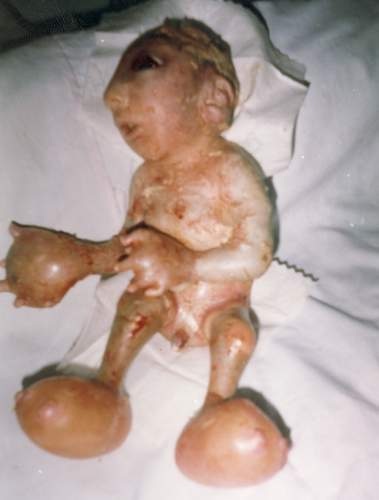
Forget about oil, occupation, terrorism or even Al-Qaeda. The real hazard for Iraqis these days is cancer from depleted uranium munitions used by the American military. Cancer is spreading like wildfire in Iraq. Thousands of infants are being born with deformities. Doctors say they are struggling to cope with the rise of cancer and birth defects, especially in cities subjected to heavy American and British bombardment.But, hey, it's cheaper than shipping those spent nuclear reactor rods to the toxic waste site. And the American people won't make a fuss, even if they know about it. -- right?
Somehow it must be OK. I mean they're not white or Jews. They're just Arabs. Just imagine how the media would be covering this story if it was happening to Israelis, French or Americans. Why is that so?


Collateral damage? Another Fallujah youngster born with six fingers on one hand.

A photograph of another disabled youngster born since the American assault on Fallujah.
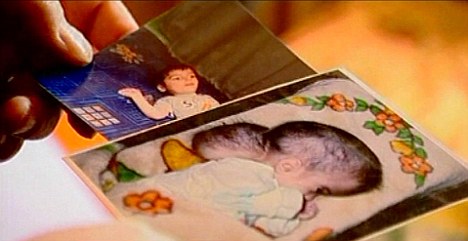
Mother's agony: BBC World Affairs Editor John Simpson is shown photographs of children with birth defects in the Fallujah clinic.

Curse of Fallujah: This little girl was born with deformed feet.

Mystery: An infant born with just one eye battling to stay alive in the Fallujah clinic.
| WHAT IS DEPLETED URANIUM?Remember when everyone was talking about what to do with all the spent rods from nuclear plants? Remember how they proposed to store them underground in Nevada in Yukka Mountain. Remember that we were told that the facility would have to store the nuclear waste for thousands of years in the future because that's how long they would remain deadly poisonous to all life? Well they found a solution to this perplexing problem. What? You didn't hear about that? Your government -- my government -- decided to dump the radioactive material on other countries. That's right, many hundreds of thousands of tons of it -- untreated and just as radioactive as ever. And they did it in our name and even used our hard earned tax money to pay for it. And it's still going on -- today -- right now! Depleted Uranium, or DU, is the waste material left over from the nuclear industry. A good portion of it comes from spent rods that have been used in nuclear energy plants but a vast amount of this waste DU is produced when natural uranium is enriched for use in nuclear reactors and nuclear weapons. Only the uranium isotope U-235 can be used in nuclear processes, such as reactors and weapons. As most of this isotope is removed from naturally occurring uranium, the remaining uranium product comprises U-238 and smaller amounts of the more highly radioactive U-235 and U-234. DU is toxic and radioactive. 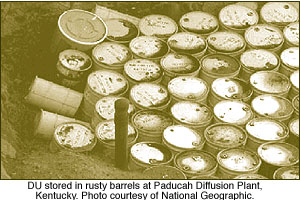 U-238 is used to make 'depleted' uranium weapons. It is used for weapons because it is a heavy, dense metal -- twice as dense as lead --and is judged by the army to be an excellent penetrator of enemy armour, tanks, and even buildings. It's the weapon of choice for the A-10 Warthog aircraft. U-238 is used to make 'depleted' uranium weapons. It is used for weapons because it is a heavy, dense metal -- twice as dense as lead --and is judged by the army to be an excellent penetrator of enemy armour, tanks, and even buildings. It's the weapon of choice for the A-10 Warthog aircraft.A large amount of "by-product" DU in the stockpiles held in the United States has been contaminated with recycled spent nuclear fuel from nuclear reactors. For example trace amounts of U-236 and highly radioactive substances such as plutonium, neptunium and technetium were found in a DU anti-tank shell used in Kosovo! Hundreds of thousands of tons of this contaminated stock was exported to the UK, France and other countries in the 1990s. The extent to which this DU has been contaminated with recycled spent fuel is still undisclosed. |
Lies and more lies... until you believe them
Governments have largely ignored the serious dangers this recycled fuel represents. A common defence used by the British and US governments and their militaries is to claim that depleted uranium is less radioactive than natural uranium and therefore does not constitute a risk to human health.
Duh! Not that lie again!
Listen, poppy seeds on my sandwich contain traces of morphine. The poppy plant is where we get morphine and codeine. But there's a big difference between eating a handful of seeds and taking the condensed and refined drug. It's the same with depleted uranium. Sure, they're both uranium, but the amounts found naturally in stones and rocks would hardly raise a few clicks on a geiger counter. Yes, they DO believe we are stupid!
In May 2003 Scott Peterson, a writer with the US newspaper CSM, examined radioactivity levels next to DU bullets in Baghdad and found Geiger-counter readings were 1900 times greater than background radiation levels next to DU bullets!
When natural uranium is concentrated in a similar form to 'depleted' uranium it emits about 40% more alpha radiation, 15% more gamma radiation and around the same level of beta radiation. The chemical toxicity of uranium does not depend on the isotope, therefore enriched, 'normal', and depleted uranium are equally toxic chemically.
It is extremely difficult and expensive for the nuclear industry to store DU. It is thought that the US currently has 1 billion tonnes of depleted uranium radioactive waste, while the UK has at least 50,000 tonnes. This waste is stored in cylinders at many sites across the US and UK and is vulnerable to corrosion and leaks owing to ageing cylinders and outside storage. It is stored mainly in the form of depleted uranium hexafluoride (DUF6) which can leak if the corroding cylinders are breached. At least 10 cylinders are known to have breached during the past 10 years.
Turning this DU waste into weapons solves some of the problem faced by the Government and nuclear industry, concerning what to do with these large stockpiles. Not only is DU practically free of charge for the arms manufacturers, but it no longer has to be stored and monitored indefinitely.
Wow. That's great - eh?

THE HEALTH EFFECTS OF DEPLETED URANIUM
Depleted uranium is a risk to health both as a toxic heavy metal and as a radioactive substance. The UK and US Governments have long sought to play down these risks. The US and UK Governments claimed that DU presents no harm to soldiers or civilians, yet accumulating and alarming evidence from scientists, soldiers and activists has forced them to back down and recognise the risks posed. However what is clear from reading all major studies is that more research urgently needs to be done. There exists very little research publicly available on the effects of uranium contamination in humans and accurate tests to understand exposure doses from military uses of DU, almost certainly done secretly, have never been reported.
How it get inside of you
 There are three main routes through which DU exposure on the battlefield takes place: inhalation, ingestion andwounding.
There are three main routes through which DU exposure on the battlefield takes place: inhalation, ingestion andwounding.
As a DU penetrator hits its target some of the DU from the weapon reacts with the air in the ensuing fire and becomes a fine dust (often called an 'aerosol') that makes inhalation and ingestion a possibility for those in the area. Even after the dust has settled, the danger remains that it may be resuspended in the future by further activity or the wind, and again pose a threat to civilians and others for many years into the future. DU particles have been reported as travelling twenty-five miles on air currents. Open wounds also allow a gateway for DU into the body and some veterans have also been left with DU fragments in their bodies, remaining after combat.
Inhaled DU dust will settle in the nose, mouth, lung, airways and guts. As a DU penetrator hits its target, the high temperatures caused by the impact ensure the DU dust particles become ceramic and therefore water insoluble. This means that, unlike other more soluble forms of uranium, DU will stay in the body for much longer periods of time. It cannot be flushed out.
This aspect of uranium toxicology has often been ignored in studies of the health effects of DU, which base their excretion rates on soluble uranium. DU dust can remain in the sticky tissues of the lung and other organs such as the kidneys for many years -- just like asbestos. It is also deposited in the bones where it can remain for up to 25 years. This helps explain why studies of Gulf War veterans have found that soldiers are still excreting DU in their urine over 12 years after the 1991 conflict!
Ingested DU can be incorporated into bone and from there will irradiate the bone marrow, increasing the risk of leukaemia and an impaired immune system.
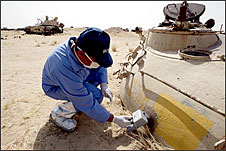 [Right: Dr. Khajak Vartaanian, a radiation expert, holds a Geiger counter next to a hole in an Iraqi tank destroyed by depleted uranium weapons in the Persian Gulf War in 1991. The shell holes show 1,000 times the normal background radiation level.]
[Right: Dr. Khajak Vartaanian, a radiation expert, holds a Geiger counter next to a hole in an Iraqi tank destroyed by depleted uranium weapons in the Persian Gulf War in 1991. The shell holes show 1,000 times the normal background radiation level.]
External exposure to DU entails exposure to alpha, beta and gamma radiation. Although the skin will block alpha particles, beta and gamma radiation can penetrate beyond the dead outer skin layers and damage living tissue. Beta particles can penetrate to a depth of 2 cm, while gamma radiation (through a process called 'the Compton effect') generates beta particle radiation along its trajectory through the body. Neither is all external exposure to alpha radiation harmless. Cataracts, for example, can be caused by exposure to alpha radiation.
Inside the body, DU poses a health risk in a variety of ways to different organs. The kidneys are the first organ to be damaged by DU. At a high dose kidney uranium levels can lead to kidney failure within a few days of exposure. Lower doses lead to kidney dysfunction, and can lead to an increased risk of kidney disease later in life.
STOP! THIS IS IMPORTANT!
You're sitting somewhere right now reading this. Maybe you're in your bedroom or office. Maybe you're a student in your dorm room. This all sounds horrible but it's so far away from you. It's "over there" and affecting babies and soldiers who look different from you. You live in a different world -- right?
Just for a second, stop. This is America that is doing this -- our country -- and they are doing it draped in flags and stories about hero soldiers and fighting for our freedoms. But a shit house with fresh paint still stinks. They are using your tax money to do these things. Are you angry yet?
Well how about those "heroes." The young kids of 18 who decide to make their family proud by joining the military. Good healthy kids who sign up and get shipped out. What about them? They get contaminated with radioactive DU powder and return home -- only to have our government deny that there is anything wrong with them or send them to psychiatric centers for imagining that they are sick. What about them? Still feel patriotic?
Our government is broken. You can't write to complain to your Congressman. They throw your letters in the heap but have a red phone to their corporate sponsors. Even the President has forgotten his promises to the people. He ramped up the use of DU in Afghanistan and has just proposed building two new nuclear reactor sites in the Atlanta area. Change?
So stop for a moment and get angry. But put a post-it note in your mind about what is happening. It's evil. Don't forget it. Try to do something about it.
Confirmed in Southern Iraq
ScienceDaily (Feb. 20, 2010) -- Childhood leukemia rates have more than doubled over the last 15 years in the southern Iraq province of Basrah, according to the study, "Trends in Childhood Leukaemia in Basrah, Iraq (1993-2007), published in the American Journal of Public Health.The authors, three of whom are from the University of Washington, say they hope their calculations can now pave the way for an investigation into reasons why the rates have climbed so high, and why they are higher than found in nearby Kuwait, or in the European Union or the United States.
The study documents 698 cases of leukemia for children aged 0-14 during the 15-year period, with a peak of 211 cases in 2006. Younger children had higher rates than older ones.
"By using a hospital cancer registry, we were able to measure a jump in leukemia rates from 3 per 100,000 youngsters in the first part of our study period, to a rate of almost 8 and a half in the final three years," said UW Department of Global Health faculty member Amy Hagopian, the paper's lead author.
By comparison, Hagopian said, the European Union and the United States report rates of 4 and 5 per 100,000, respectively. She also noted Kuwait reports a rate of approximately 2 per 100,000 and Oman reports rates between 2 and 3, depending on the gender of the child (boys typically have higher rates, as do children from higher socio-economic classes).
"Studying childhood diseases in war situations is difficult," Hagopian noted. "Aside from the normal difficulties of controlling for referral patterns changes caused by war-time conditions, the political situation is also challenging. We were constantly worried about the political risks our medical colleagues were taking by collecting and reporting these data."
Another author of the paper, UW Department of Epidemiology Chairman Scott Davis, noted, "Another challenge was securing population data for purposes of calculating rates." He said census data were not collected after the U.S. invasion of Iraq and population patterns were thought to be disrupted by migration patterns, as well. Study authors say they used the most conservative assumptions available, so as not to overstate their findings.
The study was conceived by faculty at University of Washington and two Iraqi universities -- Mustansiriya University in Baghdad and Basrah University -- and the Fred Hutchinson Cancer Research Center in Seattle. The authors formed an ongoing partnership to support public health in Iraq after the 2003 U.S. invasion.
During the period studied, Basrah and its highly populated surrounding area, which includes farmland and oil fields, became a modern battlefield, pummeled by three consecutive wars, including the Iran-Iraq war in the 1980s, the first U.S. invasion in 1991and the second U.S. invasion in 2003.
The researchers now seek to understand the cause of Iraq's increased rate of child leukemia by conducting a case-control study to compare children who got leukemia with those who did not. That sort of study allows researchers to see if there were differences in exposures between the cases and the controls. Some increased exposures related to child leukemia could include the byproducts of regional petroleum fires and benzene, which comes from gasoline sold by children at the side of the road as a result of disrupted fuel supplies, war-related nerve agents and pesticides, and the widespread use of depleted uranium munitions.
The study documents 698 cases of leukemia for children aged 0-14 during the 15-year period, with a peak of 211 cases in 2006. Younger children had higher rates than older ones.
"By using a hospital cancer registry, we were able to measure a jump in leukemia rates from 3 per 100,000 youngsters in the first part of our study period, to a rate of almost 8 and a half in the final three years," said UW Department of Global Health faculty member Amy Hagopian, the paper's lead author.
By comparison, Hagopian said, the European Union and the United States report rates of 4 and 5 per 100,000, respectively. She also noted Kuwait reports a rate of approximately 2 per 100,000 and Oman reports rates between 2 and 3, depending on the gender of the child (boys typically have higher rates, as do children from higher socio-economic classes).
"Studying childhood diseases in war situations is difficult," Hagopian noted. "Aside from the normal difficulties of controlling for referral patterns changes caused by war-time conditions, the political situation is also challenging. We were constantly worried about the political risks our medical colleagues were taking by collecting and reporting these data."
Another author of the paper, UW Department of Epidemiology Chairman Scott Davis, noted, "Another challenge was securing population data for purposes of calculating rates." He said census data were not collected after the U.S. invasion of Iraq and population patterns were thought to be disrupted by migration patterns, as well. Study authors say they used the most conservative assumptions available, so as not to overstate their findings.
The study was conceived by faculty at University of Washington and two Iraqi universities -- Mustansiriya University in Baghdad and Basrah University -- and the Fred Hutchinson Cancer Research Center in Seattle. The authors formed an ongoing partnership to support public health in Iraq after the 2003 U.S. invasion.
During the period studied, Basrah and its highly populated surrounding area, which includes farmland and oil fields, became a modern battlefield, pummeled by three consecutive wars, including the Iran-Iraq war in the 1980s, the first U.S. invasion in 1991and the second U.S. invasion in 2003.
The researchers now seek to understand the cause of Iraq's increased rate of child leukemia by conducting a case-control study to compare children who got leukemia with those who did not. That sort of study allows researchers to see if there were differences in exposures between the cases and the controls. Some increased exposures related to child leukemia could include the byproducts of regional petroleum fires and benzene, which comes from gasoline sold by children at the side of the road as a result of disrupted fuel supplies, war-related nerve agents and pesticides, and the widespread use of depleted uranium munitions.
No comments:
Post a Comment